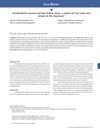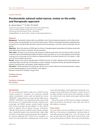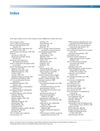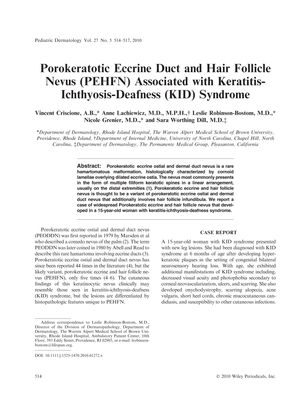TLDR A 15-year-old with KID syndrome developed a rare skin condition called PEHFN.
The document reported a case of a 15-year-old woman with keratitis-ichthyosis-deafness (KID) syndrome who developed widespread porokeratotic eccrine and hair follicle nevus (PEHFN). PEHFN is a rare hamartomatous malformation characterized by cornoid lamellae overlying dilated eccrine ostia and involves hair follicle infundibula. This condition typically presents as multiple filiform keratotic spines in a linear arrangement, often on the distal extremities. The case highlighted the association between PEHFN and KID syndrome, suggesting a potential link between these rare conditions.
60 citations
,
August 2009 in “Journal of the American Academy of Dermatology” The term "porokeratotic adnexal ostial nevus" is proposed to unify overlapping skin conditions involving eccrine and hair follicles.
 5 citations
,
January 2017 in “Anais brasileiros de dermatologia/Anais Brasileiros de Dermatologia”
5 citations
,
January 2017 in “Anais brasileiros de dermatologia/Anais Brasileiros de Dermatologia” Porokeratotic eccrine and hair follicle nevus is a very rare skin disorder possibly caused by a GJB2 gene mutation.
4 citations
,
January 2019 in “Indian Dermatology Online Journal” The term "Porokeratotic Adnexal Ostial Nevus" is suggested as a more appropriate name.
 23 citations
,
September 2014 in “JEADV. Journal of the European Academy of Dermatology and Venereology/Journal of the European Academy of Dermatology and Venereology”
23 citations
,
September 2014 in “JEADV. Journal of the European Academy of Dermatology and Venereology/Journal of the European Academy of Dermatology and Venereology” Laser treatments are the most effective for porokeratotic adnexal ostial nevus.

Researchers found a genetic link for hereditary hair loss but need more analysis to identify the exact gene.
 November 2019 in “Harper's Textbook of Pediatric Dermatology”
November 2019 in “Harper's Textbook of Pediatric Dermatology” The document is a detailed medical reference on skin and genetic disorders.




